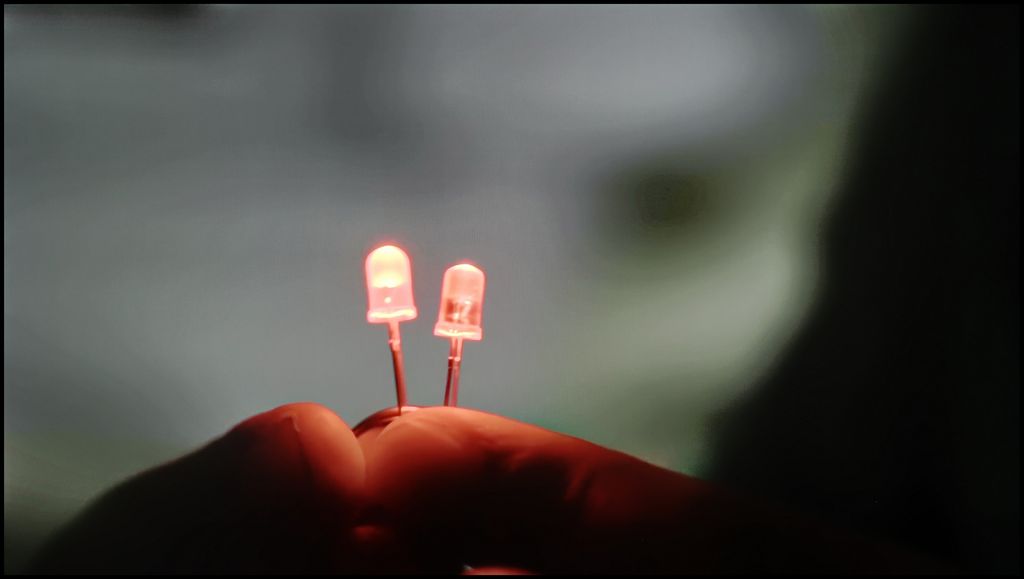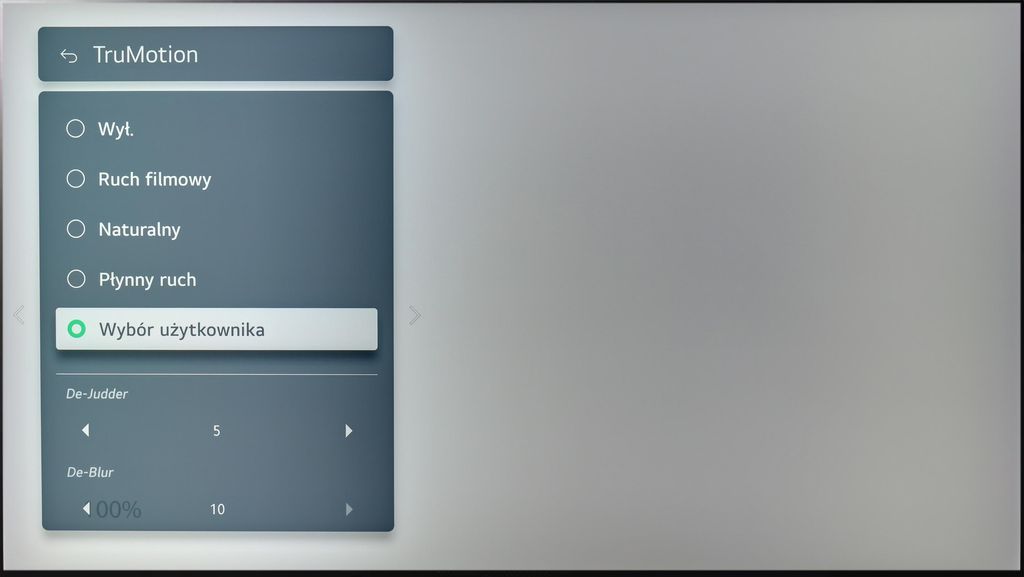- Matching (Score)
- Our verdict
- Competing TVs
- TV appearance
- Where to buy
- Contrast and black detail
- HDR effect quality
- Factory color reproduction
- Color reproduction after calibration
- Smoothness of tonal transitions
- Image scaling and smoothness of tonal transitions
- Blur and motion smoothness
- Console compatibility and gaming features
- Input lag
- Compatibility with PC
- Viewing angles
- Daytime performance
- TV features
- Apps
- Playing files from USB
- Sound
- Panel details
LG OLED G4 Review
G45 / G42
Available screen sizes:

Complete the survey to find out the result
Panel type: WRGB OLED Refresh rate: 144Hz Brand: LG Resolution: 3840x2160 System: WebOS Model year: 2024
LG G4 - Our verdict
8.5
Overall rating
The LG G4 is a top contender for the best television of 2024, offering an exceptional viewing experience. Combining OLED black with MLA technology, it delivers a dynamic and detailed image, making it ideal even for sunny rooms. The operating system, while not as open as some competitors, offers a lot of functionality, with the standout feature being the intuitive remote control with a cursor, ensuring ease of use. Out of the box, colour reproduction is solid, but after calibration, it reaches almost reference quality, providing a truly cinematic image. Post-production studios favour this brand for its deep calibration capabilities, including 3D LUT adjustment.
The TV does have some issues with tonal transitions, but these can be largely remedied by enabling the "Smooth Gradation" feature, improving the viewing experience. The motion smoother is highly advanced, catering to sports and dynamic content with adjustable fluidity. With HDMI 2.1 ports supporting full functionality, including low input lag, the TV is perfect for gamers. Overall, the LG G4 is a versatile and high-quality television, offering superb performance both day and night.
Advantages
Phenomenal image fidelity to the director's intent
Reference color reproduction after calibration
Very high brightness in HDR materials
Remarkable compatibility with console and computer
The panel suppresses reflections very well
Perfect viewing angles
Disadvantages
Visible tonal transitions
Sound of the built-in audio system - could be better in this class of television
Movies and series in UHD quality
8.6
Classic TV, YouTube
9.1
Sports broadcasts (TV and apps)
9.0
Gaming on console
9.5
TV as a computer monitor
8.6
Watching in bright light
5.8
Utility functions
9.0
Apps
9.1
Sound quality
8.6
Complete the survey to find out what fits your preferences
LG G4 - Competing TVs in this price range
LG G4 - TV appearance
HDMI inputs: 0 x HDMI 2.0, 4 x HDMI 2.1 (48Gbps) Outputs: Toslink (Optical audio), eARC (HDMI), ARC (HDMI) Network Interfaces: Wi-Fi 2.4GHz, Wi-Fi 5GHz, Ethernet (LAN) 100Mbps
Build quality: Super Premium
Bezel color: Silver







Stand:
Flat design: Yes
Accessories: Stand, Wall bracket
Buy at the best price
Select size:
LG G4 - Contrast and black detail
10/10

Result
∞:1

Result
∞:1

Result
∞:1

Result
∞:1

Result
∞:1
Visibility of details in the lights:

The LG G4, benefiting from over a decade of OLED panel development, excels in contrast, black levels, and detail reproduction, especially in the darkest scenes. Incorporating MLA (Micro Lens Array) technology further enhances this, improving brightness and handling light reflections effectively, making the TV a strong performer in sunlit rooms. OLED technology offers perfect blacks by turning off individual pixels, which results in exceptional immersion and a three-dimensional effect, surpassing even some of the best Mini LED models. This is particularly evident in challenging scenes from films like The Revenant, where even the finest details are captured with remarkable clarity.
The black levels in the LG OLED G4 are nearly flawless, amplifying the depth and realism of high-contrast scenes. The TV’s high contrast, combined with deep blacks, delivers an immersive viewing experience, making it stand out in a crowded market of competing models.
Halo effect and black detail visibility:
LG G4 - HDR effect quality
7.9/10
Supported formats: HDR10, Dolby Vision, HLG Color gamut coverage: DCI P3: 98.3%, Bt.2020: 74.7%
Luminance measurements in HDR:

Result
1474 nit

Result
1467 nit

Result
1403 nit

Result
1441 nit

Result
850 nit
The LG G4 excels in delivering an incredibly vivid HDR experience, positioning it as one of the best models in its class. Equipped with second-generation Micro Lens Array (MLA) technology, it achieves a remarkable peak brightness of 1474 nits in real-world scenes. While it may not match Mini LED-backlit LCD TVs in full-screen white scenes, the overall performance is outstanding. The fine details in HDR content shine brightly, a distinct advantage of OLED technology over non-OLED displays. With this impressive brightness and wide DCI-P3 colour gamut coverage, HDR content is brought to life with unmatched engagement and immersion.
Scene from the movie “Pan” (about 2800 nits)

Scene from the movie “Billy Lynn” (about 1100 nits)

After calibration, the LG G4 impressively captures the director's vision in each film. A particularly challenging scene from "Pan," mastered at 2800 nits, is handled with ease, preserving the fine details of the sun and clouds without over-brightening or darkening them. Similarly, the scene from "Billy Lynn," with its mix of bright and dark details, is nearly perfect, maintaining a realistic balance between the fireworks and the deep black background. The colours are vivid and lifelike, thanks to 98% DCI-P3 coverage. While the BT.2020 coverage is lower, this is not a concern for now, as most films are not yet produced in that colour space.
HDR luminance chart:
HDR luminance
Luminance of RGB colors
The LG G4 excels in difficult HDR scenes due to its high brightness and ability to handle static metadata in films. This ensures that the image isn't overly darkened while maintaining good detail in the highlights. The subtle loss of tonal transitions is noticeable only in the background.
Equipped with Dolby Vision, the G4 can also handle dynamic metadata, which enables slightly higher brightness and better detail in the whites. While the difference is subtle, it becomes noticeable in challenging scenes, enhancing the overall picture quality. However, it's worth noting that such demanding scenes are rare in most films.
Static HDR10

Dynamic: Dolby Vision

Factory color reproduction
8.4/10
Before calibration, the "Filmmaker" mode on the TV had a noticeable red and green colour dominance, resulting in a warm-yellow hue across both SDR and HDR content. This warm tone, typical of modes like "Cinema" and "Filmmaker," led to a yellowish cast that was evident when switching from the "Standard" mode.
Looking at the brightness characteristics, the Gamma chart showed decent performance for mid-tones and bright whites, but it struggled with the darkest details, which tended to merge into a black blob. HDR content, as represented by the EOTF curve chart, displayed a drop in contrast due to excessive brightness, which overshadowed fine details and negatively affected the overall image quality. Additionally, the "ColourChecker" chart revealed that colours were under-saturated, contributing to a less accurate and vibrant visual experience.
This provided a good foundation to build on, but calibration was needed to bring out the full potential of the "Filmmaker" mode and address these issues.
Color reproduction after calibration
9.5/10
The manufacturer has been offering extensive support for the calibration process in its LG televisions for many years. Therefore, we used 2- and 20-point grayscale adjustments along with an advanced CMS (Colour Management System) to optimise the display. As shown, the calibration procedure greatly improved each parameter. The results included studio-quality colour reproduction, enhanced detail in dark areas, corrected brightness characteristics, and accurate colour saturation. This led to a near-perfect match with the reference image—the one the film director saw on the preview monitor. It’s also worth mentioning that LG G4 televisions are unique in offering even deeper image adjustments through 3D LUT matrices, a feature primarily suited for post-production or graphics studios.


LG G4 - Smoothness of tonal transitions
6.2/10
The tonal transitions on the LG G4 are not among the best in class. Every scene played from a Blu-ray disc with 10-bit HDR showed noticeable inconsistencies in colour transitions. This was particularly evident in "The Green Knight," where posterization issues were especially noticeable. Similar problems were observed in films with moderate to high brightness, such as "The Martian" or "Kingsman," which is unusual for televisions of this calibre and was quite surprising. These results suggest that in scenes with low luminance and a lot of black, this issue may become bothersome, even for casual viewers.








Image scaling and smoothness of tonal transitions
8.2/10
Smooth transition function

Image without overscan on the SD signal

The LG G4 does not perform well with materials rich in tonal transitions, leading to a pronounced posterization effect. However, the manufacturer has included a smoothing system called "Gentle Gradation," with three levels: Low, Medium, and High. These settings are effective at smoothing bright colours, though less so for darker tones. It is recommended to use the Low setting, as the higher levels can distort the director's intentions by removing film grain.
When it comes to upscaling lower-quality material, the television's performance is quite good, delivering a sharp and clear image. However, attention should be paid to the jagged edges of fine details and the occasional halo effect around figures. This occurs due to the sharpening imposed by the LG G4, even when the lowest setting is selected (0). This is a noticeable change from the LG G3, which did not apply such strong sharpening, even at setting 0.
LG G4 - Blur and motion smoothness
8.5/10
Maximum refresh rate of the panel: 144Hz
Film motion smoothing option: Yes
Blur reduction option: Yes
BFI function 60Hz: Yes, 60Hz (image flickers)
BFI function 120Hz: No
Brightness drop with BFI: 50%

The LG G4 offers a maximum refresh rate of 144 Hz, achievable when connected to a powerful PC. For most users, however, the TV operates at a maximum of 120 Hz, ideal for watching sports or other content with fast motion. To improve image fluidity, the television includes the "TrueMotion" motion smoothing system, which features two separate sliders: De-Blur (for the sharpness of moving images) and De-Judder (for judder reduction). These sliders allow users to adjust the level of smoothing between 0 and 10, ensuring everyone can find the ideal setting.
With a response time of 0.78 ms, the LG G4 delivers exceptionally clear images, outperforming LCD televisions, which can have much slower response times. This results in no trailing blur behind moving objects, as shown in the "UFO Test." The TV also provides precise control over motion smoothing, which is especially beneficial during fast-paced video game sequences. Thanks to OLED technology, the G4 eliminates ghosting, ensuring a crisp and clear image even during the most dynamic sports or action scenes.
Blur (native resolution, maximum refresh rate):



Blur (BFI function enabled):
Image flickers in this mode



An additional feature of the LG G4 aimed at improving image fluidity is "OLED Motion," which utilises black frame insertion (BFI) between movie frames to "reset" the retina, thereby enhancing image sharpness. However, this feature has a significant drawback: it causes noticeable flickering when enabled, making it largely ineffective. Furthermore, enabling OLED Motion reduces the television's brightness by half and prevents adjustments to the De-Blur and De-Judder sliders, limiting its overall usefulness.
LG G4 - Console compatibility and gaming features
10/10
ALLM: Yes
VRR: Yes
VRR range: 40 - 144Hz
Dolby Vision Game Mode: Yes
Correct implementation of HGIG: Yes
1080p@120Hz: Yes
1440p@120Hz: Yes
4K@120Hz: Yes
Game bar: Yes


The LG G4 TV supports all the features encompassed by the HDMI 2.1 standard, making it a gaming powerhouse. During testing, every feature activated seamlessly, ensuring a smooth experience for both console gamers and PC users. Notably, the HGIG mode (HDR Gaming Interest Group) is implemented correctly, allowing games mastered to brightness levels higher than the TV’s maximum luminance to map tones accurately, preserving the game’s original visual integrity.
A notable highlight is the dedicated GameBar, which can be accessed at any time to quickly check or adjust game settings. More importantly, enabling VRR (Variable Refresh Rate) does not compromise contrast—a common issue in TVs with local dimming or Mini LED backlighting. This is thanks to the OLED panel’s self-emissive pixels, which maintain consistent contrast. However, a slight grey flicker may appear when VRR is enabled, though this is standard across OLEDs.
In summary, the LG G4, like most OLED TVs, is ideal for gaming and online competitions. Its HDMI 2.1 ports offer a full 48 Gbps bandwidth, supporting features such as VRR, ALLM (Auto Low Latency Mode), G-Sync, FreeSync, and HDR Dolby Vision gameplay, ensuring an exceptional gaming experience.



LG G4 - Input lag
10/10
The LG G4 excels in lag time performance, maintaining impressively low input lag across all scenarios. Even the most demanding gamers will appreciate its remarkably low input lag of just 5 ms at 4K 120 Hz with HDR enabled. This remains consistent even with Dolby Vision HDR activated—something that many competitors struggle to achieve. Such outstanding performance earns the LG G4 top marks and a strong recommendation for gamers seeking a responsive, lag-free experience.
| SDR | HDR | Dolby Vision |
|---|---|---|
| 1080p60: 14 ms | 2160p60: 13 ms | 2160p60 DV: 13 ms |
| 1080p120: 5 ms | 2160p120: 5 ms | 2160p120 DV: 5 ms |
| 2160p60: 14 ms | ||
| 2160p120: 5 ms |

LG G4 - Compatibility with PC
8.6/10
Chroma 444 (maximum resolution and refresh rate): Yes
Font clarity: Good
Readability of dark text and shapes: Very Good
Input lag in PC mode (4K, maximum refresh rate): 5ms
Matrix subpixel arrangement: RWBG
Max refresh rate: 144Hz
G-Sync: Yes
The LG G4 performs exceptionally well when connected to a PC, thanks to its ultra-low 5 ms latency, ensuring near-instantaneous responsiveness between mouse input, visual perception, and on-screen action. This makes it ideal for both gaming and productivity tasks.
A standout feature is the excellent text readability, a crucial aspect for extended screen use. The RWBG pixel arrangement does not negatively impact the display of fonts or characters, a clear advantage over Samsung’s QD-OLED matrices, which can sometimes struggle with text clarity. Users of both Windows and macOS will find the LG G4’s screen performance highly satisfying, making it a versatile choice for various computing needs.
LG G4 - Viewing angles
9.7/10
Brightness drop at an angle of 45 degrees: 9%
The LG G4 OLED's MLA technology ensures consistent brightness, colour saturation, and white balance from all viewing angles, a clear advantage over standard LCD and non-MLA OLED panels. This uniformity remains intact regardless of where you're seated, offering an excellent viewing experience. Comparable performance is seen only in Samsung’s QD-OLED panels, which use quantum dot technology.
LG G4 - Daytime performance
5.8/10


Panel finish: Glare
Reflection suppression: Good
Black levels during daytime: Average
The LG G4’s glossy display coating, contrary to expectations, is a major strength. It enhances the TV’s efficiency by suppressing reflections at their source, ensuring a clear, distraction-free viewing experience. Notably, the black levels remain impressive even in daylight, a hallmark of LG Display’s WRGB panels. While OLED MLA panels are slightly less effective in this regard, they still outperform Samsung’s QD-OLED panels, which tend to appear grey in bright conditions. With a brightness of around 500 nits and a glossy coating, the TV is ideal for daytime use, except in rooms with extensive glazing.
Panel brightness
Average luminance SDR
LG OLED G4: 482 cd/m2
LG G4 - TV features
9/10
System: WebOS
System performance: Very good
- HDMI inputs: 0 x HDMI 2.0, 4 x HDMI 2.1 48Gbps
- Outputs: Toslink (Optical audio), eARC (HDMI), ARC (HDMI)
- Network Interfaces: Wi-Fi 2.4GHz, Wi-Fi 5GHz, Ethernet (LAN) 100Mbps
- TV reception: DVB-T, DVB-T2, DVB-S, DVB-S2, DVB-C
Classic features:
Recording to USB (terrestrial TV): Yes
Recording programming: Yes
Picture in Picture (PiP): No
RF remote control (no need to aim at the screen): RF
Backlit remote control: No
Teletext: Yes
Audio only mode: Yes
Bluetooth headphones support: Yes
Simultaneous Bluetooth headphones & TV audio: Yes
Smart features:
AirPlay: Yes
Screen mirroring (Windows Miracast): Yes
Voice search: Yes
Voice search in native language: Yes
Ability to connect a keyboard and mouse: Yes




LG’s long-standing proprietary WebOS system offers nearly all key applications, with only a few notable omissions like CDA and KODI. A standout feature is the motion-sensitive cursor, which appears when moving the remote, making tasks such as entering queries or passwords much easier. WebOS also supports screen mirroring, AirPlay, Polish voice search, and Bluetooth headphone connections. Uniquely, it allows simultaneous use of headphones and the TV speaker, a valuable feature for those with hearing impairments.
Sports enthusiasts will appreciate the match alert function, ensuring they never miss a game, while the home panel enables control of smart devices within the network—such as receiving laundry cycle completion notifications.
Overall, though WebOS may not be as widely recognised or versatile as Android TV, it delivers fast, stable performance and covers most essential functions, making it a reliable choice for users seeking a straightforward, effective TV operating system.
Sound connection options
HDMI audio:
Other audio outputs:
Toslink: Yes
Wireless audio:
Bluetooth: Yes
Obsługiwane formaty audio:
Dolby Digital Plus 7.1: Yes
Dolby True HD 7.1: Yes
Dolby Atmos in Dolby Digital Plus (JOC): Yes
Dolby Atmos in Dolby True HD: Yes
DTS:X in DTS-HD MA: Yes
DTS-HD Master Audio: Yes
Ułatwienia dla seniorów
Numeric keyboard on TV: Yes
Font size adjustment: No
Audio description: Yes
LG G4 - Apps
9.1/10























LG G4 - Playing files from USB
8.5/10

| Maximum photo resolution: | Supported photo formats: |
|---|---|
The default file player on the LG G4 handles most photo formats well, though it's surprising that a few popular ones are missing. Video playback is excellent, supporting nearly all common formats, including Dolby Vision, with the only exception being the H.266 VVC codec—currently rarely used. However, photo format support is limited to just JPEG and PNG, which may disappoint Apple users due to the lack of HEIC compatibility, the default format for iPhone photos. Fortunately, this can be bypassed using the built-in AirPlay feature. It's also worth noting that the player does not support TXT subtitles, which could be an inconvenience for some users.
LG G4 - Sound
8.6/10
-
Maximum volume
Supported codecs
(TV speakers)
Dolby Digital Plus 7.1
Dolby True HD 7.1
Dolby Atmos in Dolby Digital Plus (JOC)
Dolby Atmos in Dolby True HD
DTS:X in DTS-HD MA
DTS-HD Master Audio
Audio quality is always subjective, but the LG G4 deserves recognition for its sound clarity. The primary drawback is its limited bass range, though this is less of an issue for those who plan to pair the TV with a home theatre system. Crucially, the LG G4 offers extensive support for audio codecs, including DTS-HD Master Audio and Dolby Atmos, ensuring compatibility with a wide range of high-quality audio setups.
Acoustic Measurements
No acoustic data
LG G4 - Panel details
Software version during testing: 03.10.85
Subpixel Structure:

Panel uniformity and thermal imaging:

Founder and originator of the "ChooseTV" portal

Journalist, reviewer, and columnist for the "ChooseTV" portal
See articles related to LG OLED G4:
1/16/2025
1/16/2025
6/20/2025
6/13/2025
2/28/2025











